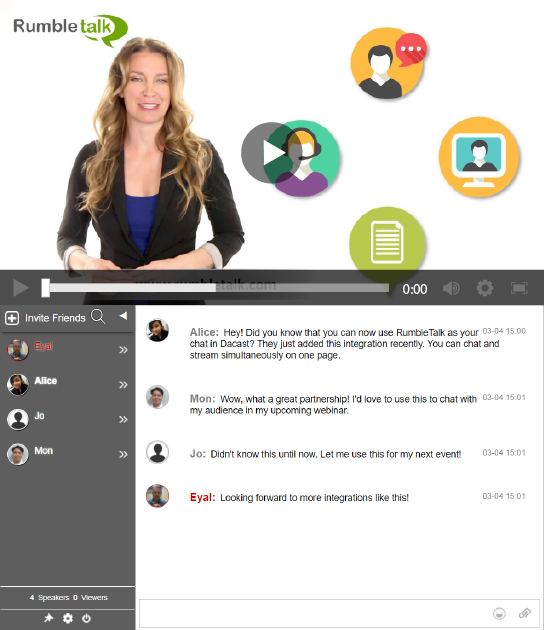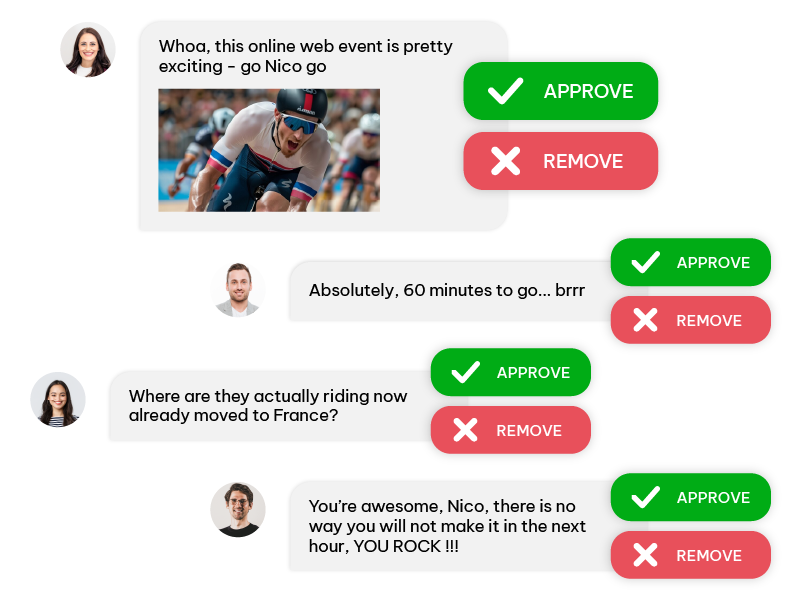In the fast-paced world of virtual and hybrid live events, engaging your audience is more important than ever. Whether you are hosting a product launch, a conference, a music festival, or a live podcast, ensuring that your audience stays connected and involved throughout the event can be the difference between success and a disengaged crowd. This is where a tool for live events like a real-time chat solution integrated with your live stream can make all the difference.
Combining live-streaming video with an interactive chat platform creates a powerful engagement tool that keeps your audience involved, informed, and entertained. Let’s explore why a chat tool is the ultimate companion for any live event and how it can be easily integrated into your broadcast setup.
Why Interaction Matters at Live Events
Live events thrive on audience participation. Whether virtual, hybrid, or fully in-person, interaction is the key to making your event memorable and impactful. Here are some reasons why incorporating a tool for live events like a chat room can revolutionize your audience experience:
- Boost Engagement: Audiences are more likely to stay tuned when they can ask questions, give feedback, and share opinions during the event.
- Build a Community: Real-time conversations between attendees foster networking and a sense of belonging.
- Drive Audience Insights: Live chats allow event hosts to gather valuable feedback and understand audience sentiment instantly.
- Encourage Participation: Viewers who interact are more likely to remain focused and participate in polls, Q&A sessions, and other activities.
Key Features of a Chat Tool for Live Events
A chat tool designed specifically for live events should offer:
- Real-Time Messaging: Instant audience interaction without delay.
- Moderation Tools: The ability to control discussions, filter inappropriate content, and block disruptive users.
- Custom Branding: Customizable chat design to match your event’s theme.
- Private and Group Chats: Flexibility to enable public discussions or private messages.
- Audience Polling: Conduct polls and surveys during the event.
- Q&A Management: Organize audience questions and present them to speakers efficiently.
Use Cases for Live Event Interaction Tools
Where can you use these tools? Here are examples where individuals and big companies use them.
1. Corporate Webinars
Keep employees or stakeholders engaged during virtual presentations by allowing them to ask questions and respond to live polls.
2. Product Launches
Enable potential customers to interact with your team and receive immediate answers to their product queries.
3. Virtual Conferences
Facilitate networking and audience interaction by creating topic-specific chat rooms within the conference platform.
4. Online Music Festivals
Let fans interact during performances, request songs, and share their excitement.
5. Religious Services
Offer a space for prayer requests and community interaction during live-streamed services.
Easy Integration Using SDK and API
Adding an interactive chat room to your live event is easier than you might think. With the help of an SDK (Software Development Kit) and an API (Application Programming Interface), you can integrate a chat tool into your event platform seamlessly.
SDK for User Integration
The SDK is perfect for integrating your event’s user base into the chat. It enables auto-login so that participants can access the chat without needing to sign in separately. This can be implemented manually or through the built-in functionality available in RumbleTalk’s WordPress Plugin.
REST API for Custom Chat Solutions
Using the REST API, you can create custom chat rooms, manage user roles, and enable auto-login features. This is particularly useful for large-scale events requiring unique chat configurations.
Here’s an example of PHP code using the RumbleTalk API to create a user and enable auto-login:
<?php
$api_key = 'YOUR_API_KEY';
$api_secret = 'YOUR_API_SECRET';
$url = 'https://api.rumbletalk.com/rest/rooms/YOUR_ROOM_ID/users';
$data = [
'name' => 'EventGuest',
'role' => 'member'
];
$options = [
'http' => [
'header' => "Content-Type: application/json\r\nAuthorization: Basic " . base64_encode($api_key . ':' . $api_secret),
'method' => 'POST',
'content' => json_encode($data),
]
];
$context = stream_context_create($options);
$result = file_get_contents($url, false, $context);
echo $result;
?>Example: Integrating Chat with a Dacast Live Stream
For a practical example, let’s say you are hosting a virtual conference using Dacast for live streaming. You can embed your video player alongside a chat room for audience interaction.
<div style="display: flex;">
<div style="flex: 70%;">
<iframe src="https://iframe.dacast.com/b/XXXX/c/XXXX" width="100%" height="400" frameborder="0" scrolling="no" allowfullscreen></iframe>
</div>
<div style="flex: 30%;">
<iframe src="https://rumbletalk.com/client/chat.php?XXXXX" width="100%" height="400" frameborder="0"></iframe>
</div>
</div>Real-World Success Stories
Here are some scenarios wherein they used a chat for live events and saw success in numbers.
Stock Market Analysts
Live market update sessions use chat tools to allow viewers to discuss stock trends and ask questions.
Online Education Platforms
Educators use chat rooms during live lessons to answer student queries and facilitate group discussions.
Virtual Music Events
Artists host online concerts where fans chat, request songs, and engage with performers in real-time.
Business Webinars
Companies host product demos and Q&A sessions using chat tools to connect with their audience.
Don’t let your chat dwindle
After exploring the role of interactive chat tools in live events, my conclusion is clear: audience engagement is no longer a luxury—it is a necessity. Modern live events, whether virtual, hybrid, or physical, demand a real-time feedback loop between organizers and attendees. Without this, audience interest can quickly dwindle, leading to a less impactful event.
Integrating a tool for live events that combines live streaming with an interactive chat component fosters active participation, builds a community, and provides invaluable insights during the event. It transforms your audience from passive observers into active contributors, ensuring that your message resonates.
From corporate webinars to music festivals and virtual classrooms, the need for audience involvement is universal. Tools like RumbleTalk’s WordPress Plugin, alongside SDKs and APIs, simplify the process of embedding chat features, making it accessible to both small organizers and large corporations.
Ultimately, the future of live events lies in creating a truly interactive environment. Leveraging the right chat solutions will not only enhance your audience’s experience but also elevate the overall success of your event. Don’t let your next event fall flat—embrace the power of interaction and watch your audience thrive.











